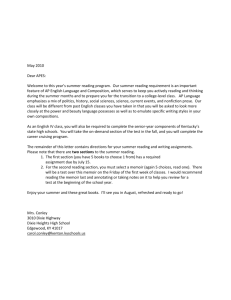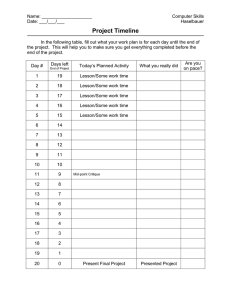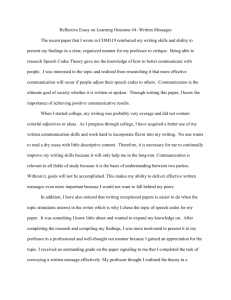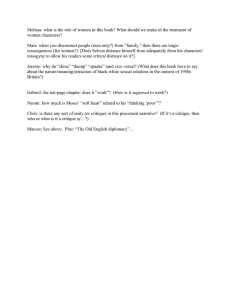toaz.info-creative-nonfiction-12-q2-mod4-critiquing-creative-nonfiction-pr 2cfb98e1b400056af006bc9e0bcd02af
advertisement
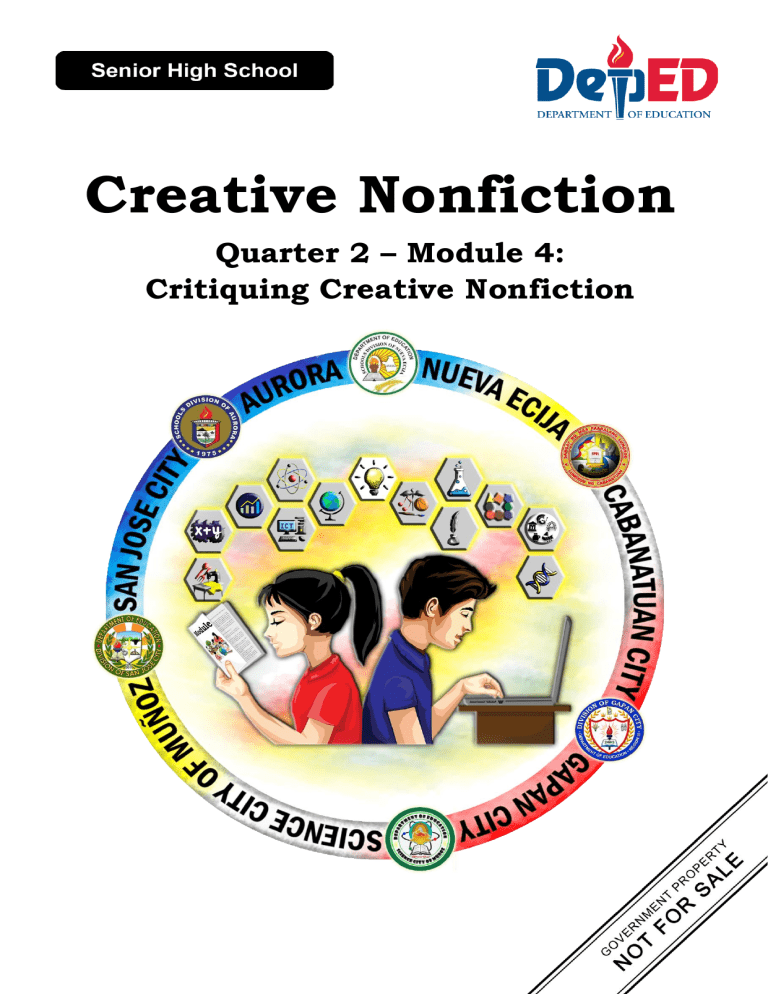
Creative Nonfiction Quarter 2 – Module 4: Critiquing Creative Nonfiction Creative Nonfiction – Grade 11/12 Alternative Delivery Mode Quarter 2 – Module 4: Critiquing Creative Nonfiction First Edition, 2020 Republic Act 8293, section 176 states that: No copyright shall subsist in any work of the Government of the Philippines. However, prior approval of the government agency or office wherein the work is created shall be necessary for the exploitation of such work for a profit. Such agency or office may, among other things, impose as a condition the payment of royalties. Borrowed materials (i.e., songs, stories, poems, pictures, photos, brand names, trademarks, etc.) included in this module are owned by their respective copyright holders. Every effort has been exerted to locate and seek permission to use these materials from their respective copyright owners. The publisher and authors do not represent nor claim ownership over them. Published by the Department of Education, SDO Nueva Ecija Schools Division Superintendent: Jessie D. Ferrer, CESO V Assistant Schools Division Superintendents: Mina Gracia L. Acosta, PhD, CESO VI Ronilo E. Hilario Development Team of the Module Writer: Mira Pearl A. Baldoviso Editor: Ma. Checilia S. Bagsic, PhD Layout Evaluator: Lyndon M. Ibarra Cover Designer: Mark G. Asuncion Management Team: Jayne M. Garcia, EdD Ma. Checilia S. Bagsic, PhD Beverly T. Mangulabnan, PhD Eleanor A. Manibog, PhD Printed in the Philippines by Department of Education – Region III – Schools Division of Nueva Ecija Office Address Telefax E-mail Address :Brgy. Rizal, Santa Rosa, Nueva Ecija, 3101 :(044) 940-3121 :nuevaecija@deped.gov.ph What I Need to Know This module was designed and written for the learners. After going through this module, the learner is expected to: Write a mini critique of a peer’s work based on coherence and organization of paragraphs, development of literary elements, use of factual information, and other qualities concerning form and content. (HUMSS_CNF11/12-IId-e-18), specifically: 1. Recognize the characteristics of a critique; 2. Peer-edit and revise other’s draft based on a well- written creative nonfiction; and 3. Write a mini critique of a peer’s work. What I Know Choose the letter of the correct answer. Write your answers on a separate sheet of paper. 1. It means to judge failings and weaknesses. A. Assess B. Critique C. Critic D. Evaluate 2. It refers to to the systematic way of analyzing written words. A. Assess B. Critique C. Critic D. Evaluate 3. The following statements are true about a critique, EXCEPT: A. It is only professional writers can critique. B. It is the ability to decide on the importance of something. C. It considers how the work relates to a broader issue or context. D. It gives the general opinion of the work. 4. The following are ways to evaluate a written work, EXCEPT: A. Develop an understanding of the main argument or purpose being expressed in the work. B. Consider how the work relates to a broader issue or context. C. State the writer’s name and the title. D. State whether the writer is successful in making his/her point. 5. A creative nonfiction type that focuses on reflection and establishing an emotional connection, rather than simply presenting the facts around personal life. A. Traditional Authobiography B. Feature Story C. Personal Narrative Essay D. Memoir 1 Lesson 1 Critiquing Creative Nonfiction Before one can be a good writer, one should be a voracious reader. Reading helps broaden knowledge and ideas. It is also a form of self-discovery and inspiration. It can let you experience things that you never thought possible and can bring you to places you can only dream of. As you read, feedback and personal evaluation are being provided in a form of a critique. While a critic is judging and finding the weakness of a written work, critique is a systematic way of assessing and discerning written words to improve your writing and other fellow writers. Thus, you need to learn how to critique to gain essential skills in reading and writing. What’s In In the previous lessons, you learned tips in writing Autobiography, Feature Story, and Personal Narrative Essay that will help you to be able to perform this task. Identify which types of Creative Nonfiction are the following excerpts. You may choose from the options given inside the box. Write the letter of your answer on a separate sheet of paper. A. Autobiography B. Feature Story C. Personal Narrative Essay ______1. “Are you ready?” asks the pathologist. I nod, making a chalice of my hands, and he reaches down into the plastic bucket and lifts my son’s heart and lungs out of the water. I feel a slight weight as if I am holding a kitten or a bird. I blink and the world turns sideways beneath me.” ~The Fateful Discovery a Woman Made After the Sudden Death of Her Infant Child by Rebecca Gummere ______2. “I was born a poor man, the son of a school teacher in one of the smallest towns in the Philippines -Baler. My father had, besides his salary, a two-hectare riceland which he cultivated. While I was a boy and during my early youth, my father saved as much as he could from his meager salary and from what he could get from his rice-field, only to have a few hundred pesos with which to give me an education.” ~Manuel L. Quezon 2 ______3. “Passing hence from infancy, I came to boyhood, or rather it came to me, displacing infancy. Nor did that depart,—(for whither went it?)—and yet it was no more. For I was no longer a speechless infant, but a speaking boy. This I remember; and have since observed how I learned to speak. It was not that my elders taught me words (as, soon after, other learning) in any set method; but I, longing by cries and broken accents and various motions of my limbs to express my thoughts, that so I might have my will, and yet unable to express all I willed, or to whom I willed, did myself, by the understanding which Thou, my God, gavest me, practice the sounds in my memory. ~The Confessions of Saint Agustine _____4. “Eleven years after the devastation wrought by tropical storm ‘Ondoy’ (Ketsana) on September 26, 2009, we watched the same scenes of people on top of their roofs, streets covered with floodwater, people wading through waist-deep water, their possessions on their heads – in Marikina and some parts of Quezon City. Two days later, we read messages of desperate pleas – and watched on various platforms of social media –more heartbreaking scenes in Cagayan and Isabela provinces, where neighborhoods and highways were covered with water. Authorities called it “massive flooding, the worst one they had experienced.” ~Where are we in our disaster preparedness timeline? _____5. One reason I think we get so angry mad at our children is that we can. Who else can you talk to like this? Can you imagine hissing at your partner, “You get off the phone NOW! No, NOT in five minutes …”? Or saying to a friend, “You get over here right this second! And the longer you make me wait, the worse it’s going to be for you.” ~Mother Rage: Theory and Practice by Anne Lamott _____6. Despite having the second-largest number of infections in Southeast Asia, the pandemic situation in the Philippines has provided an opportunity for all stakeholders to strategically plan and innovate quality healthcare delivery during the response, based on principles contained in the Asia Pacific Strategy for Emerging Diseases (APSED III). The World Health Organization (WHO) Philippines supports the Department of Health (DOH) and subnational areas in the Philippines with technical expertise to build up national and local level responses for expansion of diagnostic capacity, early contact tracing and management, expansion of healthcare pathways and strengthening surveillance systems and risk communication. ~WHO supports DOH and subnational areas in the Philippines for COVID-19 response _____7. “It doesn’t mean you still want to be with that person,” he says. “It doesn’t mean there’s something wrong with you. It means there’s complex physiology associated with romantic attachments that probably stays with us for most of our lives — and that’s not something to be afraid of, particularly if you had a great run.” 3 ~Your Brain’s response to Your Ex According to Neuroscience by Amy Paturel _____8. “When I walked out of prison, that was my mission, to liberate the oppressed and the oppressor both. Some say that has now been achieved. But I know that that is not the case. The truth is that we are not yet free; we have merely achieved the freedom to be free, the right not to be oppressed. We have not taken the final step of our journey, but the first step on a longer and even more difficult road. For to be free is not merely to cast off one’s chains, but to live in a way that respects and enhances the freedom of others. The true test of our devotion to freedom is just beginning. ~Nelson Mandela, Long Walk to Freedom _____9. Koreanovela, a word that has been coined through the combination of the words Korean and Telenovela or television dramas, has long had a special place in the hearts of many Filipinos. But, K-Dramas in the Philippines reached yet another milestone as the wildly popular hit drama “Crash Landing on You” and “Itaewon Class” came through the streaming application, Netflix. ~K-Dramas and K-Culture: A shared experience between the Philippines and Korea during the pandemic by Han Dong-man _____10. Saturday, June 20, 1942 “My father was 36 when he married my mother, who was then 25. My sister Margot was born in 1926. I followed on June 12, 1929, and, as we are Jewish, we emigrated to Holland in 1933, where my father was appointed Managing Director of Travis NV. This firm is in close contact with the firm Kolen and Company in the same building, of which my father is a partner. The rest of our family, however, felt the full impact of Hitler’s snit-Semitic laws, so life was filled with anxiety. In 1938 after the pograms1, my two uncles escaped to the USA. ~Anne Frank: The Diary of a Young Girl 4 What’s New Read and comprehend the Personal Narrative Essay written by a High School student and answer the questions that follow. My Greatest Instrument Some people express themselves through beautiful art; others are masters of the page and speak silently through writing. I, on the other hand, express myself with the greatest instrument I have, my voice. I make my living by speaking to groups large and small. Nothing gives me more satisfaction than public speaking, and my interest in public speaking began when I was quite young. At age eight I realized that I belonged in front of an audience. I started giving demonstrations and speeches in local county 4-H competitions until I was eligible to participate in state competitions. I won every state competition that I entered. Soon other public speaking opportunities arose; I represented an artist named Ann Cross at the Art Walk in Keene and was an active participant on the debate team and the captain in eighth grade. During March of eighth grade, I had the best opportunity yet to practice my oratorical skills: I was selected, out of all the students entered in New Hampshire, to write and read a four-minute speech on national television. My job was to introduce Elizabeth Dole, who at the time was interested in running for president. I was notified the day before the event and so had only one night to write and memorize my speech. When I arrived the next morning in Bedford, New Hampshire, I was greeted by photographers, camera crews, and newspaper reporters! Then I was escorted backstage to meet Elizabeth Dole. After speaking briefly with her and having her review my speech, we marched through a crowd of flashing bulbs to our places on the stage. Soon it was time for my speech. I was introduced, and as I walked to the podium, I couldn’t help but smile at the audience. I had a feeling of complete exhilaration flowing through my veins. When I finished, I received a standing ovation, and Mrs. Dole surprised me by giving me a great hug and thanking me for my comments on the importance of education. But even after she finished speaking, the excitement was far from over. I was with her for all her photographs, and I was interviewed for a few moments by WMUR and later by the Keene Sentinel. After the media finished with us, I met various supporters of Mrs. Dole’s. They were all happy to meet me and flooded me with questions and praise. I truly felt on top of the world. 1. Does the writer have a clear but understated purpose to the essay? 2. Does the essay contain suspense or tension that is resolved in some way? 3. Does the essay make good use of concrete description, anecdote, and dialogue? 4. Does the essay help you to feel the emotions rather than just describe the emotions of the author? 5. Does the essay reveal a significant aspect of the writer’s personality? 5 What is It As you read and understand the featured Personal Narrative Essay, you have somehow performed a personal assessment of creative nonfiction. The questions you answered are actually detailed questions to consider when responding to a given written work. What is a Critique? Critique is a systematic way of analyzing written words. It came from the French word kritikē, which is the ability to decide the importance of something. It is a form of giving reaction and personal assessment as feedback on what you read. By critiquing, you are acquiring skills in reading and writing as well as helping fellow writers to improve. Although you may not be a professional writer, in peer-critiquing, by giving your response, as the reader of a text, your feedback is acceptable and it will be appreciated by the author as you can easily identify the strength and weakness of their writing. Thus, comment objectively and respectfully. EXTRA! The sandwich method is a form of feedback that wraps negative feedback in praise. This means that the feedback discussion starts with positive comments, and is followed by negative criticism, before appreciative words are used again. The aim of this method is to create a pleasant atmosphere for discussion and to relax the severity of the negative criticism. How do you critique? In critiquing, regardless of the type of creative nonfiction, consider the following: 1. Content: Consider the topic and the way the topic is developed like the clarity, its scope, subcategories, amount and type of examples, anecdotes, evidence, etc. 2. Organization: Consider the text introduced and concluded, whether the thesis is located in the most helpful place (direct or implied), how it is structured, whether the order or extent of development is successful, as well as how individual paragraphs are organized (clear topic sentences, appropriate and concrete evidence, logical organization of evidence). 3. Style: Style can refer to the overall style: whether the tone is appropriate (humorous, serious, reflective, satirical, etc.), whether you use sufficient and appropriate variety (factual, analytical, evaluative, reflective), whether you use sufficient creativity. 6 4. Correctness: Correctness refers to grammar, punctuation, and form of creative nonfiction. What are the steps in writing a mini critique? 1. Annotate as you read. 2. Note the writer’s main point or thesis statement. 3. Divide the text into sections of thought and write a summary of each thought in your own words. What are the parts of a mini critique? INTRODUCTION Start your mini critique with sentences giving the following information: 1. Writer’s name. 2. The title and the source if any. 3. Thesis statement. SUMMARY Summarize the author’s purpose and main points/evidence cited that are used for back up. EVALUATION 1. Develop an understanding of the main argument or purpose being expressed in the work. 2. Consider how the work relates to a broader issue or context. 3. State whether the writer is successful in making his/her point. CONCLUSION You may wrap up your creative nonfiction mini critique by: 1. Stating whether you agree with the writer or what part of the text made an impact and deep impression on you. 2. Back up your decisions on agreeing and disagreeing or state your reasons. 3. Give your general opinion of the work. 7 What’s More Memoir vs. Autobiography Previously, you learned about the guidelines on how to write an autobiography as an example of a creative nonfiction text. It is about the author’s personal information and insights. Almost the same with an autobiography, a memoir is also the story of a person's life written by that person but the difference between the two is that a memoir focuses on reflection and establishing an emotional connection, rather than simply presenting the facts around their life. Read and comprehend a sample mini critique of Elizabeth Gilbert’s memoir Eat, Pray, Love from The New York Times’ Revisiting Elizabeth Gilbert’s ‘Eat, Pray, Love’ (June 7, 2019). In Elizabeth Gilbert’s 2006 memoir “Eat, Pray, Love,” the novelist and journalist chronicle her journey across Italy, India, and Indonesia. Early on in “Eat, Pray, Love,” her travelogue of spiritual seeking, the novelist and journalist Elizabeth Gilbert gives a characteristically frank rundown of her traveling skills: tall and blond, she doesn’t blend well physically in most places; she’s lazy about research and prone to digestive woes. “But my one mighty travel talent is that I can make friends with anybody,” she writes. “I can make friends with the dead. … If there isn’t anyone else around to talk to, I could probably make friends with a four-foot-tall pile of Sheetrock.” This is easy to believe. If a more likable writer than Gilbert is currently in print, I haven’t found him or her. And I don’t mean this as a consolation prize, along the lines of But she’s nice. I mean that Gilbert’s prose is fueled by a mix of intelligence, wit, and colloquial exuberance that is close to irresistible, and makes the reader only too glad to join the posse of friends and devotees who have the pleasure of listening in. 8 What I Have Learned After reading, Revisiting Elizabeth Gilbert’s ‘Eat, Pray, Love’ complete the table below with the parts of a mini critique. Parts Guide questions INTRODUCTION State whose memoir and the title of the memoir. What is the thesis statement? SUMMARY Summary of the memoir. EVALUATION Did the writer like the memoir? Why or Why not? CONCLUSION What is the writer’s opinion of the memoir? general What I Can Do Peer–Critiquing Activity 1 You will be assigned to critique a classmate’s autobiography written in the previous lesson. Write a 300 to a 400-word mini critique of your classmate’s autobiography following the steps and the parts of writing a mini critique on pages 7-8. Use a separate paper for your mini critique. 9 You will be graded following the rubric below. Positive Feedback Critique included what you liked most about the text: 1 Point 2 Points 3 Points 4 Points 5 Points Positive feedback was not descriptive Positive feedback was given and somewhat descriptive, but not relevant to the text Positive feedback was relevant and somewhat descriptive Positive feedback was relevant and the description was fair Very descriptive and thorough Suggestions were made but showed a lack of effort Suggestions were made but lacked detail Suggestions were made and descriptive but not effective towards the text Many suggestions were made but could have been more descriptive Suggestions were wellconsidered, thorough, and fair More comments should have been made Comments were not descriptive Comments need to be more descriptive Comments were fair but could have been more thorough Suggestions Your suggestions showed that you carefully read your classmate's autobiography Grading Your Classmate Your comments on your classmate's autobiography were descriptive. Comments were thorough and complete (https://www.rcampus.com/rubricshowc.cfm?sp=yes&code=D93879&) Activity 2 Revise your classmate’s autobiography based on a well- written creative nonfiction. Take note of the criteria below from which you will be graded. Use a separate paper for the revised autobiography. Creativity-----40 % (words,style) Content--------40 % (clarity) Impact---------20% 100% 10 Assessment Read again the Personal Narrative Essay, My Greatest Instrument on pages 4-6. Using the comprehension and guide questions that you answered, write a 300 to 400-word mini critique. Use a separate paper for your own mini critique. You will be graded based on the rubric below. Criteria 5 Points 3 Points 1 Point Organization The Paper is well organized, has a very clear intro, body and conclusion. The purpose of the paper is clear from the very beginning and the name and author of the text are made clear early in the paper. The Paper is not well organized, has an unclear or nonexistent intro, body, and conclusion. The purpose of the paper is unclear and the name and author of the text are not stated or stated late. Summary The text is clearly but succinctly summarized only the key points of the text are touched upon. Critique Strengths and weaknesses that are central to the text are addressed. The Paper is organized, has an intro, body, and conclusion. The purpose of the paper becomes clear within the paper and the name and author of the text are mentioned within the paper. The text is clearly summarized, but some sub-points are addressed along with the main points. The summary is not succinct. Strengths and weaknesses that are peripheral to the text are addressed. Language Mechanics There are no grammatical errors or typos. There are few grammatical errors or typos (https://www.rcampus.com/rubricshowc.cfm?code=A22B44&sp=true) 11 The text summary is unclear or overly detailed. Strengths and weaknesses are addressed peripherally, weakly, or not at all. There are many grammatical errors and/or typos Additional Activities Critiquing Task Ask a classmate for a copy of his/her personal narrative essay done in the previous lesson. Then, using the Sandwich Method in providing your feedback (please refer to page 7) and following the steps and the parts of writing a mini critique, write a critique of your personal narrative essay. Use a separate paper for your “sandwich method” feedback. 12 13 What I have Learned? Answers of the students may vary. What I can do? Activity 1: Answers of the students may vary. Activity 2: Answers of the students may vary. In? C A A B C B C A B A What's 1. 2. 3. 4. 5. 6. 7. 8. 9. 10. know? C B A A D What I 1. 2. 3. 4. 5. What’s New? Answers of students may vary. Assessment Parts INTRODUCTION Guide Questions 1. State whose memoir and the title of the memoir. 2. What is the thesis statement? 1. Eat, Pray, Love by Elizabeth Gilbert 2. Early on in “Eat, Pray, Love,” her travelogue of spiritual seeking, the novelist and journalist Elizabeth Gilbert gives a characteristically frank rundown of her traveling skills: tall and blond, she doesn’t blend well physically in most places; she’s lazy about research and prone to digestive woes. 1. Summary of the memoir. 1. The novelist Elizabeth Gilbert chronicles her journey across Italy, India, and Indonesia by writing a memoir of her travelogue and spiritual seeking. SUMMARY 1. Did the writer like the memoir? Why or Why not? EVALUATION CONCLUSION 1. What is the writer’s general opinion of the memoir? 1. The answers of the students may vary based on their personal evaluation of the writer’s critique but take note that the writer liked the memoir along this line, “I mean that Gilbert’s prose is fueled by a mix of intelligence, wit and colloquial exuberance that is close to irresistible, and makes the reader only too glad to join the posse of friends and devotees who have the pleasure of listening in” and the memoir left the writer impression with unresolved things in the memoir along this line, “ I found myself more interested, finally, in the awkward, unresolved stuff she must have chosen to leave out.” 1. The answers of the students may vary but note that the memoir was healing and interesting to the writer. Answer Key References A. Books: Barrot, Jessie S. Academic Reading and Writing Skills for Senior High School. C&E Publishing Inc. Quezon City. 2016. Barrot, J.S. and Sipacio, J.F.S. Communicate Today English for Academic & Professional Purposes for Senior High School. C&E Publishing Inc. Quezon City. 2016. Vibal. Creative Nonfiction Senior High School Self Learning Modules. Vibal Group Inc. 2020. B. Websites: Essay Critique Guidelines Guidelines. Retrieved November 16, 2020 from https://www.goshen.edu/academics/english/essay-critiqueguidelines/#section-2 http://www.quezon.ph/familyinfo/autobiography-of-manuel-l-quezon-from-aprivilege-speech/ https://thewritelife.com/personal-narrative-examples/ https://www.gutenberg.org/files/3296/3296-h/3296-h.htm https://mb.com.ph/2020/11/18/where-are-we-in-our-disaster-preparednesstimeline/ https://www.who.int/philippines/news/feature-stories/detail/who supports-dohand-subnational-areas-in-the-philippines-for-covid-19-response http://www.januarytwenty.net/long-walk-to-freedom-excerpt/ https://www.hillsboro.k12.oh.us/userfiles/79/Classes/683/Anne%20Frank%20 %20The%20Diary%20of%20a%20Young%20Girl.pdf https://www.philstar.com/opinion/2020/07/30/2031629/k-dramas-and-k culture-shared-experience-between-philippines-and-korea-during-pandemic https://k12.thoughtfullearning.com/studentmodels/my-greatest-instrument https://www.nytimes.com/2019/06/07/books/review/elizabeth-gilbert-eat-pray love.html https://www.rcampus.com/iRubrics The Sandwich Method. Retrieved November 16, 2020 from https://www.ionos.com/startupguide/productivity/sandwichmethod/#:~:te xt=The%20sandwich%20method%20is%20a,appreciative%20words%20are% 20used%20again What is a Memoir? By Jessica Dukes Retrieved 16, 2020 from https://celadonbooks.com/what-is-a-memoir/ Writing a Critique. Retrieved November 16, 2020 from https://www.citewrite.qut.edu.au/write/critique.jsp 14
